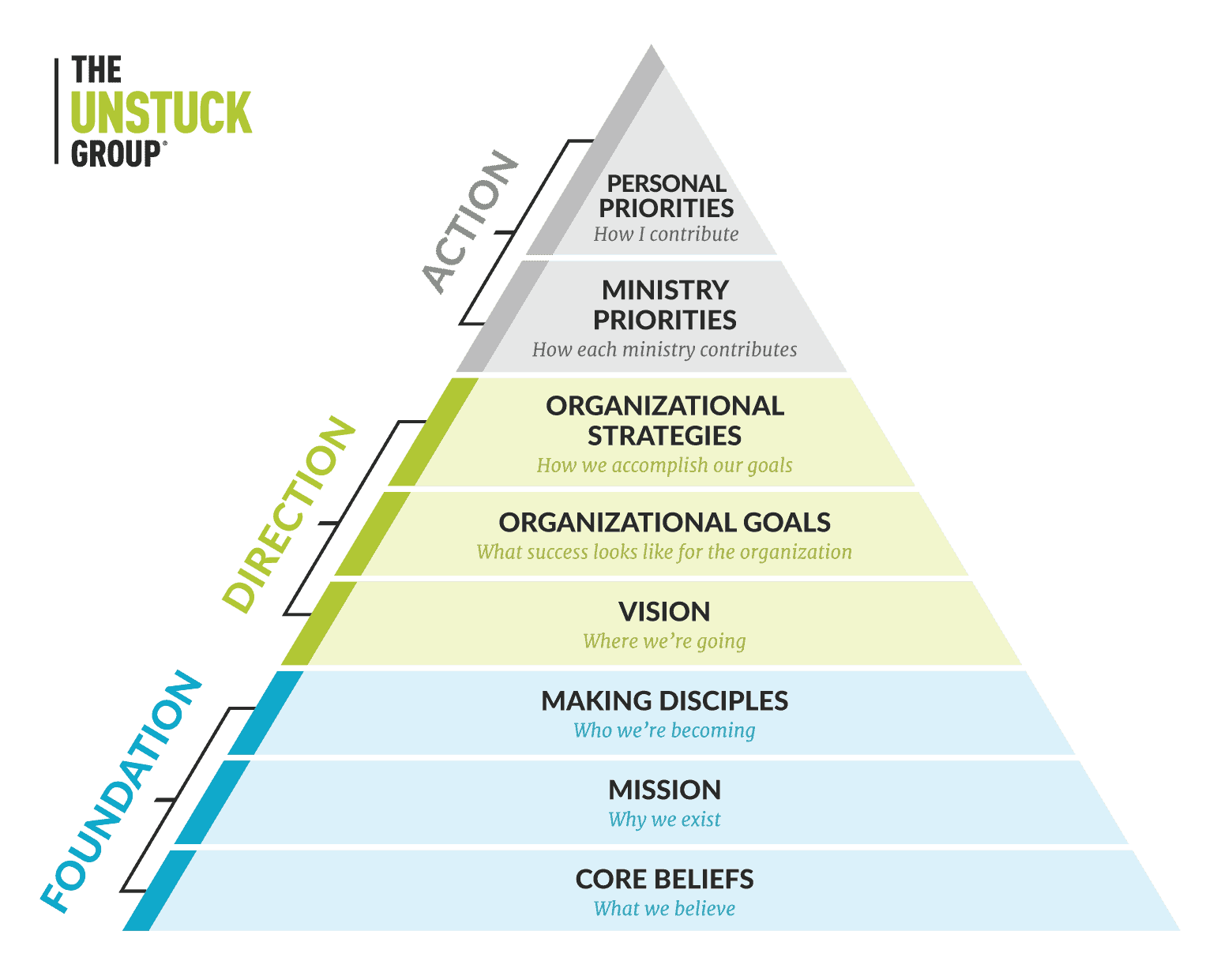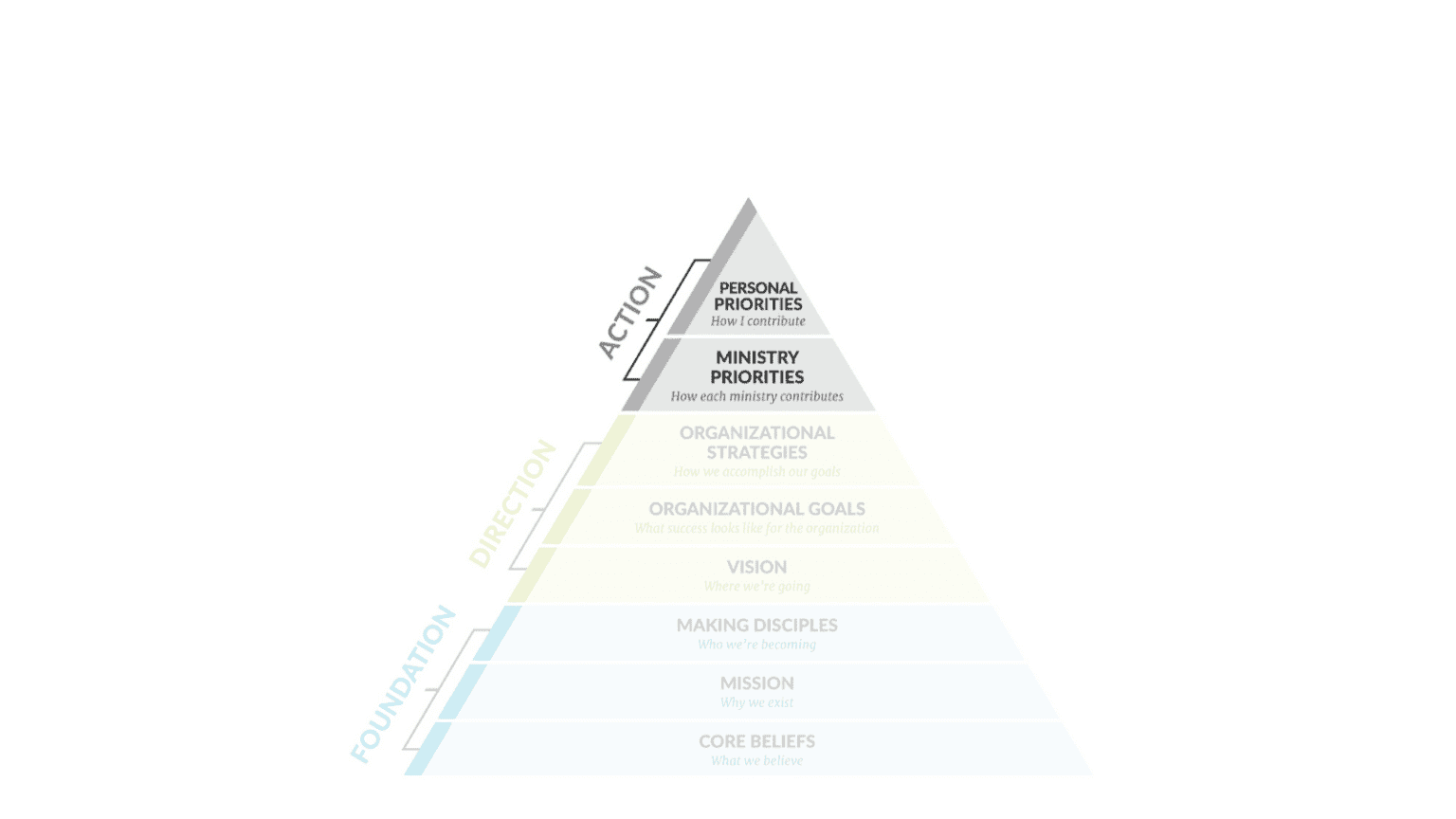Strategic Alignment Pyramid (Part 3)
If you enjoy this episode, subscribe on your device for more:
iTunes RSS Google Play Stitcher Spotify
This week, we’re wrapping up our 3 part series on the Strategic Alignment Pyramid.
We’ve had a lot of you reach out about how this tool has given you that “aha” moment of where the alignment has broken down in the past. I love how this tool can help you learn how to reinvent your strategies in a way that will unify your entire team around the mission and the right priorities, and I’m excited about how helpful it’s been for all of you.
Before we move forward, if you haven’t listened to the first two episodes in this series, I highly recommend that you listen to the Foundation and Direction episodes first.
If you haven’t done the work of defining and clarifying the foundational and directional levels, you can’t jump to the action level. You can’t build a pyramid from the top down.
But if you’ve already defined these levels with your team, I’m excited for you to dive in.

I can’t think of a church that we’ve worked with in the last 10 years that hasn’t raised concern about ministry silos in their church. Mostly because alignment within your church won’t happen on accident.
Each of the 3 levels we’ve discussed over the last few weeks have to be identified and clarified to get the results you’re praying for, and for alignment to lead to action.
In this episode, Amy and I discussed…
- Why the action level of the pyramid shouldn’t be touched until you’ve clarified the first two levels
- Why organizational goals must be defined before ministry priorities
- How to strategize your ministry priorities
- Indicators that your strategies are working (or not)
- How you organizational goals get cascaded in a multisite environment
- Defining individual priorities based on ministry priorities
- Why creating clarity around performance expectations is empowering rather than micro-managing
Leader Conversation Guide
Want to take this conversation back to a staff or senior leadership team meeting?
Our Show Notes subscribers get a PDF download that recaps the episode content and includes a discussion guide you can print out and use at an upcoming meeting.
Opt-in here and get the Leader Conversation Guide for this episode, as well as access to the archive.
Let Us Know on Social Media
We use #unstuckchurch on Twitter, and we start a real-time conversation each Wednesday morning when the episode drops. We’d really love to hear from you during this time:
- How can we be praying for you as a lead and your church?
- What stories can you share of ways churches are responding well during this crisis and focusing on opportunities instead of loss?
You can follow me @tonymorganlive and The Unstuck Group @unstuckgroup. If Facebook is where you spend your time, I’m there, too.
Links & Resources from the Episode
- How the Unstuck Process Gets Everyone Pulling in the Same Direction
- 7 Shifts Churches Need to Make Because of the Coronavirus
- Building Alignment: The Foundation | Episode 145
- Building Alignment by Clarifying Direction | Episode 146
- Coronavirus Response Resources for Pastors
Write a Review—It Helps!
Particularly on iTunes, your ratings and reviews really do help more pastors discover the podcast content I’m creating here. Would you take a minute to share your thoughts? Just open the the podcast on iTunes on your phone or computer, click Ratings & Reviews, and leave your opinion.
Transcript
Sean (00:02): Welcome to The Unstuck Church podcast, where each week we’re exploring what it means to be an unstuck church. Alignment within your church won’t happen on accident. You have to maintain it on an ongoing basis, but if your alignment doesn’t lead to clearer ministry priorities and more focused action from your team, it’s unlikely you’ll see the results you’re praying for. On this week’s podcast, Tony and Amy finish up our three week series on the strategic alignment pyramid with a conversation about how alignment leads to action. Before you’ve listened today, make sure you subscribe to get the show notes. Each week you’ll get resources to go along with the conversation as well as access to our podcast resource archive. And this week you’ll get a visual resource of the strategic alignment pyramid to go along with today’s conversation. Just go to theunstuckgroup.com/podcast and subscribe. Now let’s join Tony and Amy for this week’s conversation.
Amy (00:55): Well, for the past two weeks, we’ve been walking through a tool called the strategic alignment pyramid, and we started with the foundational level in week one and last week covered the directional level. So today we’re going to talk about the action level, and what I love about getting here is that it gets at the core purpose of why we’ve been having these conversations. You know, we developed the pyramid, Tony, the core concept behind it was to help churches build a cohesive alignment throughout their organization so that every ministry department and every team member understands how their work aligns with the mission, vision, and goals of the church.
Tony (01:30): Yeah, that’s right. I’m Amy. It’s all about alignment, everybody pulling together, and I can’t think of a church we’ve worked with over the years that hasn’t raised a concern around ministry silos or expressed that while their people were busy, ministry itself wasn’t getting much traction or there was a disconnect between what the church was wanting to accomplish and what was actually getting done. But if you’ve walked through the other layers of the pyramid, you are ready to establish clarity around what ministry teams and your team members should be accomplishing. And if you haven’t done that work yet, you can’t just jump to this level.
Amy (02:07): Yeah, as you said a few weeks ago, you can’t build a pyramid from the top down. It’s built from the bottom up. So there’s no jumping to this level, listeners, without doing the work that comes before it. But before we jump in any further, I just want to remind our listeners that if you’re subscribed to the show notes, there is a PDF of the pyramid available so that you can kind of visually follow along with us as we dive into the final two layers today that talk about aligning the actions that your team is taking. So, Tony, with that, what’s the first layer in the action level?
Tony (02:35): Yeah, you know, first of all, as you were explaining that I was thinking we should do kind of a bonus episode at some point on the funky versions of pyramids we’ve seen churches try to build. That could be pretty interesting. Yeah, before we dive into this level, let’s review what we talked about last week regarding the directional level of the pyramid. It’s at that level that leadership clearly defines three things, and this clarity is critical. I mean, we talked about vision. That’s all about where we’re going. It’s measurable. It’s specific. We like to look five years out. Where do we sense God’s calling our church? So this really does clearly define where you believe God’s calling your ministry into the future. Then we talked about organizational goals as well, and those are tied to your vision and the key steps on your discipleship path. And these are goals that you’ve set. They’re broken out by year. They clearly define success for your ministry. In other words, if we do this right, these are the results we expect our team to accomplish. And then finally, we talked about strategies. Once the organizational goals are set and defined, we need to talk about the how behind the accomplishment of those goals. And it’s after the goals are set that you determine what your core strategies are going to be that you believe will best accomplish these goals. That was all the work that we talked about last week to set us up for the conversation we’re going to have today, Amy.
Amy (04:10): Yeah, that’s a really good summary because obviously all this is building somewhere. So if a church has done the hard work of defining the components in the directional level, what’s the first layer in the action level?
Tony (04:20): Yeah, so the first layer in this level is about ministry priorities. And so now we’re taking a step beyond the overall church, the organizational-wide direction and the goals and the strategies that are organization-wide as well, and we’re going to the ministry level and we’re asking the question, how will ministries contribute to the overall goals of our churches? And at this level, ministries are defining how they will contribute to those annual organizational goals that we just mentioned. For instance, if you have a goal of connecting 200 people, new people, into serving, the next step is to determine which teams own a piece of that goal. Maybe it’s guest services as an example. Maybe they own a hundred of those 200 people that you’re trying to connect into serving opportunities. Maybe kid’s ministry owns 50, student ministry 30, outreach maybe they get 20 of the folks as part of that goal. But it’s an example of how now every ministry area knows how they will contribute to the overall goal of connecting 200 more people in serving. In other words, this is the way we drive organizational goals into ministry areas to help teams know if their work is effective or not. And it will help identify, as well, which strategies are working and which are not.
Amy (05:50): Say a little bit more about that. How does this layer inform the strategy level?
Tony (05:54): Yeah, so let’s walk through this slowly just to get you an example to see how these things connect. Let’s say Grace Church has been working through their pyramid. At the foundational level they defined serving as one of the key steps people take when they’re becoming more like Jesus. It’s just part of that spiritual formation process that we talked about a couple episodes ago. At the directional level, they determined what their core strategy would be for connecting people into serving. In other words, they didn’t just leave that up to chance. They just didn’t assume people would figure that out on their own. They developed an intentional strategy to help people use their gifts to serve in connection to the ministry. And by the way, they didn’t leave that up to each ministry area to figure out either. So in this example, let’s say that your core strategy includes four key components of vision casting, message series around what the Bible says about spiritual gifts and serving. It might also include a visual layout in the next steps lobby or on your website that highlights all the different areas where people can get connected in serving, so that people can explore the ways that they can get connected. Thirdly, maybe there’s a specific focus on connecting men and serving and maybe that includes offering a partnership with Habitat for Humanity, as an example, on a few summer projects, this will give guys a chance to try to serve as well as meet other people from their church. And then finally, maybe that strategy, the last component could include equipping current volunteers with tools and and vision to invite friends to serve alongside them. So now the church knows the strategy, and we have the organizational goal — 200 people. That’s how many people they’re trying to connect into serving, and now each ministry knows how they’re going to contribute to that overall goal. So to answer your question of how this connects, if six months into working the strategy, we see that only 10 people have taken that step, we have the wrong strategy and it’s time for a change. But if in six months, we’re ready to hit our goal, well that could indicate our strategy is effective. So this is just a picture of how goals lead to establishing the strategy that we believe will work best, but results then lead to evaluating if the strategy is really working.
Amy (08:29): And don’t you think it could also maybe indicate team performance as well?
Tony (08:33): Yeah, that’s right. I mean if guest services and outreach, for example, are knocking the ball out of the park and they’re exceeding their goals. But students, I don’t know why I always feel like I’m picking on students here, are lagging as an example. It may indicate a performance issue, either good or bad within those teams. And I love it when we’re all pulling in the same direction and every ministry understands how they connect because we get to celebrate the wins. And through that Amy, we also identify the teams that may have picked up on something helpful that’s working in their area that can also work in all the other ministry areas as well.
Amy (09:16): That’s right. Get some best practices. Alright, so just for fun because you know, I like examples. At the ministry priorities level where we’re defining how ministries contribute to organizational goals, can you give us an example of how this cascades through a multisite church where it’s a little bit more complex?
Tony (09:33): Yeah, that’s a good question. So let’s step back. In a multisite environment, you still need to set the organizational goals first. But then I like that word you used. It cascades to the campus teams in this example. So let’s say the church has an overarching goal to engage 500 higher level volunteers in the ministry of the church over the next five years. I love that. I love mobilizing more people, especially those higher capacity people and engaging the ministry that the church is trying to carry out. These are volunteers who are leading at a higher level. They’re either building and leading teams of volunteers or they’re really, you’re seeing them influence the folks around them and you want to continue to see that grow organizationally. So the big goal gets broken down annually then to maybe a hundred new leaders per year. Then that hundred leaders gets dispersed to the various campuses. And just to keep it simple, we’ll say maybe 20 new volunteer leaders per campus. Next, each campus determines what part of the 20 each of their ministry teams owns. For example, at that campus, what will kids ministry own, students, guest services groups. In this example, student ministry is going to knock the ball out of the park. They’re going to just soar here. That’s how then, the goal cascades. They get identified down to the specific ministry teams so that every ministry understands what they own. And Amy, I’m just telling you, this is so contrary, unfortunately, too oftentimes how we see churches operate and unfortunately, and again, no one’s intending to cause complexity or to be pulling in the wrong direction. Many times, the reason why there isn’t clarity at the ministry team level, it’s because the foundation hasn’t been set or the direction hasn’t been clarified. And as a result of that, those ministry silos start to form. Everybody’s just looking kind of in their own ministry area, what does success look like? And they’re working as hard as they can in their area, without intending to be causing challenge with what other ministry teams are trying to accomplish as well. But unfortunately that’s what ends up happening.
Amy (12:01): Yeah. And I think when we leave it up to the ministries to kind of determine what can you do, you know and kind of acquiesce that responsibility at a leadership level to come up with the organizational goals. That’s where some of that splintering happens. And I’m not saying, by the way, that those ministry leaders shouldn’t have a voice into those ministry goals, but I think decision rights have to lie at that senior leadership team level to go, this is what we believe God’s calling us to do, and now let’s get under the strategic part and get it down to the ministry level. All right, well let’s move on to the last layer in the action level, which is also by the way, the final layer in the pyramid overall and that’s personal priorities. Tell us about that layer.
Tony (12:38): Yeah. Amy, this final level builds on all the layers beneath it and identifies for each team member what their personal priorities and goals are for the year and because I know you’re going to ask, let me give you a specific example. Building on that multisite example we went through, let’s just say we have a student pastor at one of the campuses, and she’s responsible to engage five new high-level volunteers in her ministry. That’s what the goal has been set for her and aligns all the way back to the organizational goals of the church. Now she has to think through what are the actions that I need to give my time and attention to so that that goal is realized. So she may look at this need for five additional leaders, getting folks like that engaged in her ministry by the end of the year. She might realize, well, if that’s the end goal, then I need to identify and meet with three potential new leaders each month. And if she does that, the hope is that five of them would respond and say, yes, I want to step up and lead. I want to bring my influence to what’s happening in our student ministry. So that goal, engaging five new high level leaders, will then shape how she spends her time. It will bring clarity for her to what the win is, and she knows she can’t wait around for an announcement that sends people her way. Partly because announcements aren’t going to send people her way. We have found that out. But it really gives clarity to where her priority needs to be focused. What I mean is this, I consider myself a leader, and I have the ability to build and lead teams in a volunteer role, and I can get excited about this, excited about solving challenges like this, and if this student pastor invited me to a conversation and casted some vision around what she’s trying to accomplish in the spiritual lives of students at her church and the spiritual lives of those students’ friends as well. If she laid out the challenge like that and then invited me to be a part of the solution, I might just sign up, and I realize by saying that I have just volunteered to serve in the student ministry at my church but does that, does that make sense Amy?
Amy (14:58): Yeah, it does. It actually sounds simple and you know, that was a great example. But more than that though, it just seems really empowering. You know, when people have clarity on how they’re personally expected to contribute, I think they know how to spend their time. I think they know what to say yes to, what to say no to. I think they know what to talk to their supervisor about, I think their supervisor knows what to talk to them about. There’s just a target there. And so I would just guess, it would be much less likely to do things that aren’t unified around the organizational goals and priority to the church, you know with a system like this.
Tony (15:32): Yeah. And Amy, the thing is, high-level leaders in all of these ministry roles that we’re talking about, they really want this clarity. They’re seeking it, they’ve been waiting for it. And I think sometimes as leaders, we think, well, that’s micromanaging. I mean, I’m getting into the weeds here. I shouldn’t be giving that focus to somebody. I should allow them to be who God created them to be and develop the ministry that God wants them to develop. Well, that all sounds good, but at the end of the day, we want to be pulling together on a mission, a vision, bigger than ourselves. But we don’t know what to do unless someone defines what needs to happen at the ministry level. And then what does that mean for me in my role?
Amy (16:21): And I’ll just echo that, Tony, at staffing and structure reviews, when we ask the team to tell us what their strengths are and what their challenges are, that clarity around their role, the clarity around priorities and what the win is, it’s almost always there, as is effective meetings and communication, but we’ll talk about that another day. All right, well that’s a lot of work really to think through, this whole pyramid. But I also think it’s pretty cool to have that alignment and focus and unity within our teams. And by the way, listeners, if you feel overwhelmed, I just want to remind you that you build from the bottom up. So simply just start working, layer by layer, and you’ll get clarity and you’ll be able to build towards this top of the pyramid where you experience that unity and that alignment. So Tony, any thoughts before we wrap up both today’s conversation and this three part series we’ve been in?
Tony (17:15): Amy, it’s been fun during this series because we’re getting a lot of feedback from pastors that this pyramid has been creating kind of “aha moments” for them and for their teams. They’re starting to identify where their alignment has broken down in the past, and often it’s at that foundational or directional level, and now they know why the work of the teams is not aligned. So here’s what I know. When this alignment is in place, everyone in the organization has clarity around how their roles connect to the bigger picture. Team members are in tune with what success looks like, and they’re able to hold loosely to the methods or the strategies and much tighter to the mission itself. In other words, if vision, organizational goals and strategies are not clearly defined, then individual priorities easily become more important than ministry goals, and ministry goals become more important than the health and impact of the entire church’s ministry. And then all that activity becomes more important than helping people become more like Jesus, which is ultimately what we want to be trying to accomplish as a church. And I believe deep down, that’s exactly what every person on our ministry teams wants to be accomplishing as well. It’s just, it’s the thing that we want to be about as a church. It’s why we do church. But because all of that alignment hasn’t taken place, that’s why churches get stuck. So if you want help working through your strategic alignment, we’d love to start a conversation. You can find us at theunstuckgroup.com.
Sean (18:56): Well, thanks for joining us on this week’s podcast. If this podcast has been helpful for you, we would love your help in getting the content out to others. You can do that by subscribing on your favorite podcasting platform, giving us a review and telling somebody else about the podcast. At The Unstuck Group, we’re working every day with church leaders to help them build healthy churches by guiding them through specifically designed experiences that focus them on vision, strategy, and action. If that’s a need in your church, we’d love to talk. Start a conversation by visiting us at theunstuckgroup.com. Next week we’re back with another brand new episode, so until then, we hope you have a great week.






